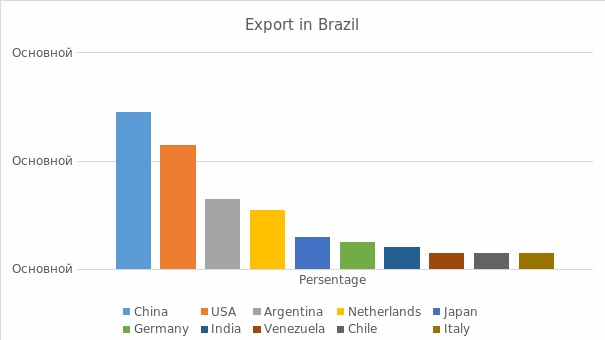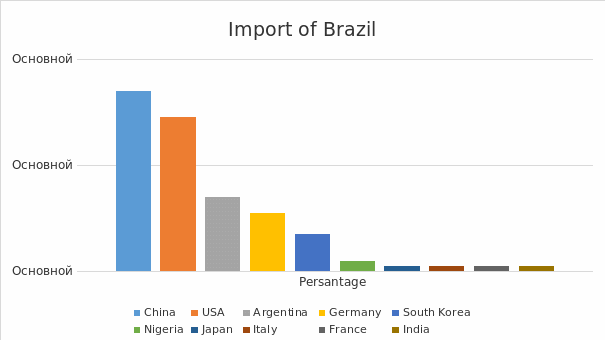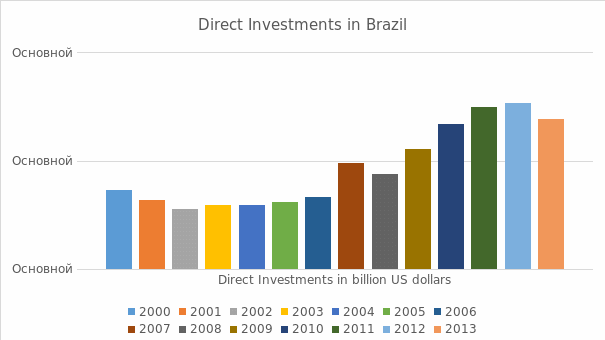Abstract
The paper examines the economic situation in Brazil during 2000-2013. The focus is laid upon the following significant issues, namely the key components of the balance of payment of the country, the composition of the capital account, the exchange rate regime, main trade partners, and the trend balance of payments of the country over time. The deeper analysis of the stated above factors provides the understanding of the improvement of the economic situation of Brazil. The provided tables and diagrams examine the significance of the provided data concerning the importing and exporting partners, direct investments, and current account of Brazil.
Introduction
The issue concerning the country’s development and improvement through the economic progress seems to be discussed and argued. A number of countries that succeeded to overcome the difficulties in industry production, economic and political challenges prove that every level of the governmental activity should be strictly controlled. According to the widespread opinion, the system of balance-of-payment in Brazil constrained the economic growth of the country. However, it should be stated that the economic system is a complicated term that is influenced by certain internal and external factors.
It should be stated that the country changed the perspectives of the international trade. The increase of the trade consequently led to the number of issues that the government took into account to eliminate the possible difficulties. The active trade relationships with the Latin America helped Brazil to expand the industry and to improve business strategies. Although, the development of the trade relationships contributed to the growth of the production improvement, as the matter of fact, it was not the only reason. The internal demand was another reason that caused the increase of the profit and credit development. The production improved significantly and was raised 10% per year, however, it should be highlighted that the progress stopped with the beginning of the international financial crises in 2009. The crises, however, did not have a significant impact on the economy of the country as it recovered by 2010. The fact that the United States and the European countries still felt the consequences of the financial crises, turned out to be an advantage for the Brazil production as Asian countries, and China as well, drew their attention towards the Latin American and Brazil market. Brazil struggled with tense competition in 2009 (Melo, 2015, p. 65).
Literature Review
According to Anthony Thirlwall, the system of the balance of payment commonly include the following components, namely “capital flows, external debt constraints, or external debt constraint plus interest payments, as well as an approach without external debt constraint (Alencar & Strachman, 2014, p. 674). The Thirlwall law is based on the idea that the income increase of one country is significantly connected to the financial environment in the world (Britto & Mccombie, 2009, p. 115). The production development and prolific ground for the improvement allowed Brazil to change the trade system and to develop the connections between the countries. John Whalley notes that the fact that China and Brazil received a primary role in the global economy was the reason to deepen the trade relationships between the countries (Whalley & Medianu, 2012, p. 707).
The author of the article The Deepening China-Brazil Economic Relationship examines the significant role of Chine and Brazil relationships and highlights that China has already become the major trading partner for Brazil. Both countries experienced the challenges that led them towards success and financial improvement. Melo examines the major reasons for the trading relationships of the countries that have differences in trade policy and strategies (Melo & Filho, 2015, p. 64).
Cardoso emphasizes the strategic nature of the trade relationship between the countries and examines the possible perspectives of the further development of the trading process (Cardoso, 2012, p. 35). The countries share a common goal, and that is, the partnership seems to be essential. Cardoso, the author of the article China-Brazil: A Strategic Partnership in an Evolving World Order highlights that China and Brazil aim to change the international trade system.
Data and Results
The economy of Brazil faced many challenges between 2000 and 2013. In 2003, Brazil stabilized the macroeconomic environment and consequently established a new level of coordination of the international trade market. It should be noted that Brazil can be considered as one of the highly developed countries of Latin America. Taking into account export and import, it should be stated that China is the largest trading partner of Brazil. According to the recent statistic, the Brazilian export index increased by more than 300% for the ten years (2002-2012) (Farah, 2013, para 3). Brazil’s major exporting partners are China, the United States, Argentina, Netherlands, Japan, Germany, India, Venezuela, Chile, and Italy.

The index of export increased almost twice in 2002 when Fernando Cardoso was the President of Brazil. Import in Brazil increased in 400% between 2000 and 2013. The major trading importing partners were China, the United States, Argentina, Germany, South Korea, Nigeria, Japan, Italy, France, and India.

The possible opportunities of the exchange rate regimes in the countries that can be considered as the developing has been discussed between policymakers (Hiroi, 2009, p. 1). Brazil experienced numerous changes of the exchange rate regimes; however, it should be pointed out that the country implements the floating exchange rate regime.
The analyzing of the economy situation of Brazil seems to be difficult as the country is progressive in one sphere and faces challenges in another. The balance of payment usually includes current account transactions and the capital and financial account. The current account transactions comprise the transactions in the sphere of goods and services production, whereas the capital and financial account deal with the direct investments and credits. The considerable growth of the gross domestic product was significantly connected with the production development. The floating exchange rate regime and focused attention on financial surplus made Brazil attractive to the countries that were looking for investments. It should be highlighted that Brazil received almost 2% of all the invested resources in 2006, whereas in 2012 the index increased almost on 3%.

The economists usually define a Brazilian cost while examining the economy in Brazil. The issue is that the prices for the products and services are much higher than the average income of the nation. The data received from the report of the International Monetary Fund, the current account of Brazil between 2000 and 2013 can be represented in the following table.
Brazil keeps to the implementation of control of the capital account. Although the complex system of the bureaucratic control is believed to influence the market economy in a negative way, Brazil is one of the most financially open countries nowadays. The current account surplus of Brazil is now almost 3% of the gross domestic product (Economic information, 2010, para. 4). According to the tendency that can be examined from 2000 until 2013, Brazil is on the way to reduce the external debt.
Discussions
The trading relationship between China and Brazil can be considered as one of the most significant turning points in the history of the modern trade. Bilateral institutions that were implemented in the political structure of both countries allowed improving the political cooperation and potential (Cardoso, 2012, p. 37). China and Brazil were connected since the 1970s; however, the strategic partnership were established only in 1993. The relationships received the priority as their connection may influence the potential international system of trade. The fast economic improvement consequently took China to the second place and Brazil to the seventh in the top list of economically powerful countries (World economic outlook: slowing growth, rising risks, p. 7). To change the vision and achieve aims these countries decided to collaborate with Russia and India (Cardoso, 2012, p. 37).
The floating exchange rate system in Brazil serves as the stimulus to the borrowers to dedicate more attention towards all the risks, especially related to the non-tradable structure. The liberalization of the capital account was seen an essential part of the Brazil strategy in 2000-2013. The process of liberalization consequently led to the tax elimination regarding the foreign capital transactions and elimination of the barriers regarding the investments.
The intensive development of the relationships between Brazil and China reached the turning point during 2000-2002. The connection became closer when China received the needed support from Brazil during the time when China intended to become the member of the World Trade Organization. Moreover, Brazil played the significant role while regulating the conflict between the United States and Japan, proving that the Latin American countries can play a primary role on the world arena. After the financial crises of 2008, Brazil and China cooperate to eliminate negative consequences for both countries. In 2011, the president of Brazil, Dilma Rousseff, and the prime minister of China, Wen Jiabalo, agreed to ratify the plan for ten years (2012-2021) that establishes official collaboration in the sphere of science, space technologies, and innovations. The relationships between China and Brazil are centered on the following principle, namely the significance of the export of raw materials for satisfying the needs of the impressive internal market. China was looking for the soybeans and oil providers, and it should be highlighted that this fact made Brazil dependent from the Asian country. China has a great opportunity to invest the capital for the Latin American country, that can be seen as an advantage for such countries like Brazil that does not have unlimited financial sources. China financed almost 150 projects in 2000-2012 and invested more than 25 billion of dollars (Brazil: economic outlook and perspectives, para. 1).
The economy of Brazil is characterized by the highly developed agricultural sector, mining industry, and the sphere of service. 2001-2003 were prolific years for the economic growth and national currency of Brazil. The stabilized situation of the economy is significantly dependent on raw materials. The professional implementation of the macroeconomic policy contributed to the increasing if the salaries and the reduction of the external debts. The floating exchange rate, inflationary orientation, and strict fiscal policy can be considered as the guiding components of the economic program in Brazil. The government aims to achieve the economic growth and eliminate the debt. 2011 was characterized by slow progress in the field of finances as the country decided to reform the tax and health care services. The major problem that time was the high exchange rate of the Brazilian real in comparison to American dollar and euro. The immediate response of the Brazilian government optimized the consequences and decreased the exchange rate. However, it should be stressed that despite the decisions made by the government, the unstable Brazilian real influenced the condition of export. In 2012 and 2013, the government struggled with another issue, the high inflation. Although, the attempts to decrease the exchange rate were taken, it did not help until the negative economic environment of 2013 influenced the Brazilian real and supported the export.
Conclusion
In conclusion, it should be pointed out that the results and knowledge gained from the research provide the deeper understanding of the processes that the government of Brazil implemented to achieve the economic growth. Brazil changed the world vision and relationship with countries to undergo the changes. Certain political and financial decisions proved that Brazil is attractive for the foreign investments. According to the recent researchers, Brazil is believed to be one of the countries that receive the biggest amount of investments. The competitive market influenced the way the country deals with the partners. One of the major strategic partners of Brazil is China. The long-lasting collaboration proves that China and Brazil cooperate to change the rules of the international trade. Although the country still faces economic and political challenges, they can be viewed as the guiding power towards success and prosperity, as overcoming the difficulties help to achieve the best results.
References
Alencar, D., & Strachman, E. (2014). Balance-of-payments-constrained growth in Brazil: 1951-2008. Journal of Post Keynesian Economics, 36(4), 673-698.
Brazil: Economic outlook and perspectives. (2010). Web.
Britto, G., & Mccombie, J. (2009). Thirlwall’s law and the long-term equilibrium growth rate: An application to Brazil. Journal of Post Keynesian Economics, 32(1), 115-136.
Cardoso, D. (2012). China-Brazil: A Strategic partnership in an evolving world order. East Asia, 30(1), 35-51.
Economic Information. (2015). Web.
Farah, A. (2013). Largest trading partners of Brazil. Web.
Hiroi, T. (2009). Exchange rate regime, central bank independence, and political business cycles in Brazil. Studies in Comparative International Development, 44(1), 1-22.
Melo, M., & Filho, A. (2015). The political economy of Brazil-China trade relations, 2000-2010. Latin American Perspectives, 42(6), 64-87.
Whalley, J., & Medianu, D. (2012). The deepening China-Brazil economic relationship. Economic Studies, 59(4), 707-730.
World economic outlook: Slowing growth, rising risks. (2011). Web.